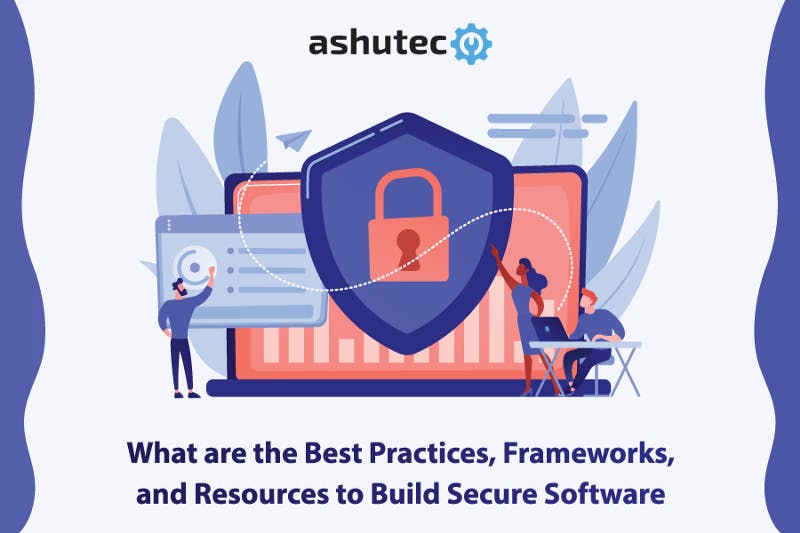Let’s Connect!
Work can be a fun when we know and understand each other well. Let's start conversation to new beginning
+91 63542 35108
To discuss what we can do for you Give us a Call
connect@ashutec.com
Tell us about your next project Write to us

Considering the recent surge in the successful execution of cyberattacks, developing safe and secure software has become the most important and first priority for any software development organization. Security of online software applications can make or break a company. So, how can you ensure your company has developed or got secure software products?
The answer to this question is more important today than ever before. When software developers ignore security issues, they expose their products to cyber risks. The only way to avert such risks is to follow the best practices and use secure frameworks and resources to build secure software products.
Today, we are going to have a look at some of the best practices and frameworks software app developers can use to safeguard their products. But before I dive into this, let’s understand what is secure software development?
Secure software development is a process often connected to DevSecOps to create software products keeping the security at every stage of the development lifecycle in mind. Security protocols are incorporated into software code from its inception rather than addressed when testing reveals some vulnerabilities.
Software security becomes the foremost part of the planning stage even before a single line of code is written. Often security is the most overlooked part of software development as developers view it as an impediment to innovation and creativity and delay the time-to-market of the product.
This can hurt your bottom line as it’s more costly to fix a bug during implementation and testing than to fix it during the design phase. Most importantly, will your software users be okay with you compromising on the security front to add new cool features?
Security should be your priority while developing software products and failing to do so will have its own repercussions. That said, let’s now look at some best practices for secure software development:
Developing extremely secure software applications in today’s threat-expanding environment is a challenge for many but not an impossible task. Keeping that in view, here I’m presenting some of the best practices for building the safest software:
Before writing a single line of code, plan how you can integrate security into every phase of your software development lifecycle (SDLC). Use the power of automation during testing to monitor vulnerability from day one. It should be incorporated into your code and there’s no better place to start from the beginning.
A policy will act as a guideline for preparing your process, people, and technology to perform secure development. This offers specific instructions to approach and integrate security in each stage of the SDLC. Additionally, it provides some governing rules and roles to help minimize the vulnerability.
Proven secure software development frameworks like NIST SSDF will add structure and consistency to your team for adhering to best practices. They have an answer to what we do next and benefit the new software developers to build secure software products.
The first step to meeting all the security requirements is defining them clearly from the start. Train yourself and others to write code in alignment with these parameters using only secure coding practices. Also, make sure that other vendors are aware of your security compliance requirements and are fine with it too.
Make a habit to keep your code in a secure repository allowing only authorized access to prevent any kind of tampering with it. Regulate and limit all the contact with the code with stringent rules and monitor changes to preserve its integrity
Let go of the habit to review the code for vulnerability toward the end of the SDLC. Instead, use a mixture of both developer review and automated testing to examine and find any flaws in the code before deployment. Catching any of the vulnerabilities in an early stage will save a great deal of money and time while preventing developers from feeling any frustration.
Vulnerability can come up at any stage of the software development process and you must be ready to mitigate them as quickly as possible. Prepare a team, plan, and processes to follow whenever the vulnerability strikes and deal with them in real-time. The faster you detect them the better you can respond to them, which will shorten your window for exploitation.
Due to the lack of knowledge of software’s function, many software users simply remain vulnerable. Thus, offer your customers with tips and information to ensure they are protected while in the early stage of the adoption.
Developing secure software requires you to track and monitor many of the moving parts. With all checklists and actions, prepare your team and conduct weekly or monthly meetings to ensure all the necessary policies and procedures are in effect and functional.
Remain vigilant and proactive by learning root causes, spotting patterns, preventing repeat occurrence, and updating SDLC to avert any security attacks. Watch out for the latest industry trends and update yourself with the best practices to avoid risking any software breach.
One of the most challenging parts of maintaining security in the software development process is that people don’t follow through. Such human errors are at the helm of most security problems. By following the above-mentioned best practices, you can most probably avert any security vulnerability. The most important part is to plan it from the beginning.

